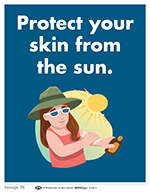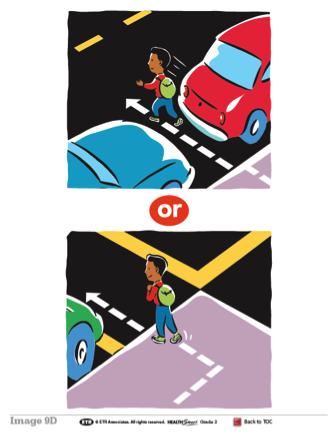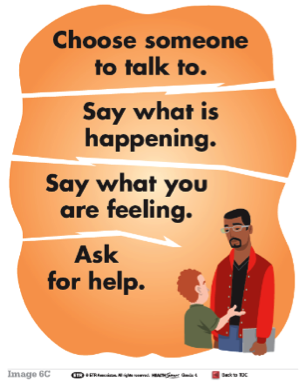Developing Health Skills: Practicing Health-Enhancing Behaviors
By Suzanne Schrag | September 5, 2019
Editor/Project Manager, ETR
I’ve been writing a series of blog posts on the key skills for health literacy outlined in the National Health Education Standards (NHES). I’ve looked at how ETR’s HealthSmart program addresses six of these skills: Analyzing Influences, Accessing Resources, Interpersonal Communication, Decision Making, Goal Setting and Advocacy.
But, for some reason, a post around skill number seven—Practicing Health-Enhancing Behaviors—has been harder for me to conceptualize and write. A recent experience suddenly gave me a new perspective on how to think and talk about this important component of a comprehensive health education program.
An Insight from a Recent Training
Along with Dr. Susan Telljohann, our lead HealthSmart developer, I was doing some professional development for a district that is implementing sexual health education within their science classes. As part of that training, we talked about the foundations of the HealthSmart program, including how it incorporates the Characteristics of an Effective Health Education Curriculum documented by the Centers for Disease Control and Prevention. One of those characteristics is that an effective curriculum “builds personal competence, social competence and self-efficacy by addressing skills.”
 Sue asked our participants to talk within their table groups about what they thought the key skills in health education might be. This was a group of skilled and dedicated science teachers, most of whom did not have a background in health education. They struggled a bit, and their eventual responses included such things as proper hygiene, getting enough exercise, eating healthy foods and knowing how to use a condom.
Sue asked our participants to talk within their table groups about what they thought the key skills in health education might be. This was a group of skilled and dedicated science teachers, most of whom did not have a background in health education. They struggled a bit, and their eventual responses included such things as proper hygiene, getting enough exercise, eating healthy foods and knowing how to use a condom.
When we started naming the actual NHES skills that I listed above, you could see nods, “ah-has” and a shift in perspective happening. I realized that thinking in terms of more generic life skills that can apply across different content areas was a new way of looking at things for these science educators. Before our training, they automatically thought in terms of the ability to perform specific behaviors that would contribute to a young person’s health.
And this is really the purpose of that seventh skill—to promote in a fully integrated way the practice of health-enhancing behaviors, and to encourage individuals to take personal responsibility for actions that will help prevent disease and injury, and will contribute positively to their quality of life.
7 Key Skills in Health Education
(Click on the links to see other posts in this series.)
- Analyzing Influences
- Accessing Resources
- Interpersonal Communication
- Decision Making
- Goal Setting
- Practicing Health-Enhancing Behaviors
- Advocacy
Taking Responsibility for Personal Health Behaviors
The performance indicators for this seventh health education standard are perhaps the most stringent. At every grade level, they call for the actual demonstration of practices and behaviors that will either maintain or improve personal health, or help avoid or reduce health risks. In addition, at every span above grades K–2, the standard also includes a performance indicator focused on responsibility: “identify responsible personal health behaviors” at Grades 3–5; “explain the importance of assuming responsibility for personal health behaviors” at Grades 6–8; and “analyze the role of individual responsibility for enhancing health” at grades 9–12.
 But how exactly do you teach to this standard? Activities that encourage self-reflection and build positive attitudes and beliefs about a particular health behavior certainly play a role in instilling a sense of personal responsibility for one’s health. Young people also need opportunities to actually practice concrete actions and behaviors, such as the steps for proper handwashing. In our HealthSmart curriculum, we made sure that if we said a lesson met Standard 7, students were indeed demonstrating a given behavior within the context and confines of a classroom situation.
But how exactly do you teach to this standard? Activities that encourage self-reflection and build positive attitudes and beliefs about a particular health behavior certainly play a role in instilling a sense of personal responsibility for one’s health. Young people also need opportunities to actually practice concrete actions and behaviors, such as the steps for proper handwashing. In our HealthSmart curriculum, we made sure that if we said a lesson met Standard 7, students were indeed demonstrating a given behavior within the context and confines of a classroom situation.
We might also argue that the practice of the different health skills in themselves are behaviors that can help maintain or improve personal health—for example, using effective communication to build healthy relationships, setting a goal to move more and sit less, or accessing reliable and trustworthy information to inform a decision. Or they might help avoid or reduce health risks—for example, defusing a conflict, refusing pressure to engage in risky sexual behaviors, or analyzing and questioning media messages that normalize or encourage drug use.
Some HealthSmart Examples
Examples of ways in which HealthSmart meets this skill standard can be found across the various content areas. At the early elementary grades, students learn and practice self-control strategies for dealing with anger or other troublesome feelings. They practice steps for proper tooth brushing and hand washing. They use a model crosswalk to demonstrate looking both ways before crossing the street. They practice dialing 9-1-1- to request help in an emergency, and demonstrate how they can crawl low and stop, drop and roll to help keep themselves safe in a fire.
 At the upper elementary grades, students continue to practice proper hygiene/handwashing steps and self-control strategies for dealing with strong feelings. They also learn and apply stress-management techniques, practice asking for adult help with bullying and serious conflict, and demonstrate healthy choices when eating at fast food restaurants.
At the upper elementary grades, students continue to practice proper hygiene/handwashing steps and self-control strategies for dealing with strong feelings. They also learn and apply stress-management techniques, practice asking for adult help with bullying and serious conflict, and demonstrate healthy choices when eating at fast food restaurants.
At the secondary levels, students demonstrate actions to prevent vision, hearing and sun damage. They identify and apply time-management skills and practice stress-reduction techniques. They have an opportunity to challenge stereotypes and advocate for respectful treatment of all their classmates. They read nutrition facts labels and apply that information to make healthier food choices, and practice strategies for preventing food-borne illness. They learn steps for positive self-talk to help promote emotional health.
Roleplay practice strengthens their demonstration of refusal skills in regard to dares, drug use and sexual behavior. They also demonstrate communication skills that will help them build healthy relationships and resolve conflict. In the HIV, STD and Pregnancy Prevention sexual health units, they have an opportunity to practice the steps to proper condom use.
Throughout grades K–12, activities also help students examine the connection between their attitudes and actions. This serves to instill a sense of personal responsibility around the health behaviors that are within their control.
The standard of practicing health-enhancing behaviors is really where the rubber meets the road. It is where students draw on the content and concepts they’ve been learning (the knowledge piece), and apply the health skills they’ve been practicing, to actually demonstrate behaviors that will enhance their health.
Check It Out
If you’re intrigued and would like to learn more about ETR’s comprehensive, skills-based, standards-aligned K–12 health education program, visit the HealthSmart website. You can also email or call ETR at 1-888-220-9455 to set up review access to the digital edition of the program.
Suzanne Schrag is the series editor of the second edition of the HealthSmart program, and a co-author of the newly revised K–5 grade levels. She can be reached at suzanne.schrag@etr.org.





